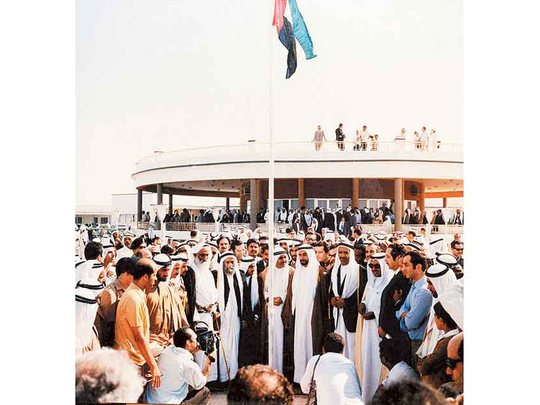
The United Arab Emirates was formed when the rulers of the small shaikhdoms of the Trucial States agreed they would become stronger together as one nation.
Although these small shaikhdoms had formed relationships with the British government from about the early 1800s, each had strong historic and tribal definitions and were fiercely independent of each other. In the 1950s, the British started a Development Office for the Trucial States, which the rulers then developed into a Trucial States Council about a decade later. When the British announced their intention to withdraw from the region in 1966, the rulers were surprised and faced with a political challenge.
The ruling families of each of the seven emirates had been in power for centuries, but their territorial authorities often varied according to the turbulent changes of tribal politics. Therefore, the rulers at the time — led by the late Shaikh Zayed Bin Sultan Al Nahyan of Abu Dhabi and Shaikh Rashid Bin Saeed Al Maktoum of Dubai — had to work hard to find a perfect formula for merging their independent sovereignties into a federation.
The terms were finalised in November 1971, after legal advisers from all the shaikhdoms met on the 14th, and the Rulers of Abu Dhabi and Dubai concluded their final discussions on the 23rd.
The foundation
On December 2, 1971, the rulers of Abu Dhabi, Dubai, Sharjah, Ajman, Fujairah and Umm Al Quwain proclaimed the creation of the new state (they were joined by Ras Al Khaimah in early 1972). This ceremony brought to fruition the communiqué of July 18, which had announced their intention to form one state: “This federation will form the nucleus of a complete federation, which will include the remaining members of the brotherly family of the emirates.”
The rulers later met in their capacity as members of the Supreme Council and elected Shaikh Zayed the first president of the country. An 18-member cabinet was appointed and each emirate’s portfolio of ministerial affairs was directly proportionate to its role in the federation. Queen Elizabeth II and Prime Minister Edward Heath of the United Kingdom were among the first world leaders to congratulate the new state.
Hours after the UAE’s formation, the country’s new Minister of State, Adnan Pachachi, flew to New York to submit an application for membership in the United Nations (UN). The former foreign minister of Iraq and erstwhile ambassador to the UN had many contacts in the international organisation, and he only had to convince two permanent members of the Security Council, China and the Soviet Union, not to veto the application.
The application was approved by the Security Council and the General Assembly, and the UAE became a member of the UN on December 9, 1971, at its 26th session. The next day, the flag of the UAE was raised outside the UN General Assembly in New York for the first time.
Elder statesman Mohammad Habroush Al Suwaidi, who had held the post of Vice-Chairman of the Emiri Diwan since 1969, was appointed as one of the UAE’s new ministers. Four days after the UAE was formed, he flew to Cairo to attend an emergency meeting of the Arab League with a specific agenda — to get the new country registered as a member of the Arab League. On December 6, 1971, the UAE became the 18th member of the association.
Political structure
To ensure effective governance, the seven rulers agreed to draw up a provisional constitution specifying powers allocated to the country’s new federal institutions. Similar to many political structures around the world, certain powers remain under the jurisdiction of the emirates, which already had their own governing institutions prior to the establishment of the federation. The balance between federal and each emirate’s authority was laid down in the constitution, but after debates ensued through the 1970s, it was resolved in 1979 with a devolved structure supported by a commitment to nurture the federal government and steadily increase its role.
Since independence, the rulers of the unified country have done much to fortify their initial ties, and weave them together into a strong national fabric. It is significant that all nationals are today proud to identify themselves first as Emirati and only then by their emirate of origin.
The solidarity between the seven emirates is a source of much pride and is represented through different symbols and emblems, as well as through events that run the course of the year. Similarly, annual celebrations commemorating the foundation of the country and its progress over time assume great patriotic fervour as the entire nation gathers together to mark unity, dignity and harmony.
Lead image
On December 2, 1971, the rulers of Abu Dhabi, Dubai, Sharjah, Ajman, Fujairah and Umm Al Quwain proclaimed the creation of the United Arab Emirates in an official ceremony in Dubai, and hoisted the UAE flag at Union House. In the picture, starting second from left, is Shaikh Mohammad Bin Rashid Al Maktoum, Minister of Defence; (fifth from left onwards) Shaikh Rashid Bin Humaid Al Nuaimi, Ruler of Ajman; Shaikh Mohammad Bin Hamad Al Sharqi, Ruler of Fujairah; Shaikh Khalid Bin Mohammad Al Qasimi, Ruler of Sharjah; Shaikh Zayed Bin Sultan Al Nahyan, President of the UAE and Ruler of Abu Dhabi; Shaikh Rashid Bin Saeed Al Maktoum, Vice-President of the UAE and Ruler of Dubai










